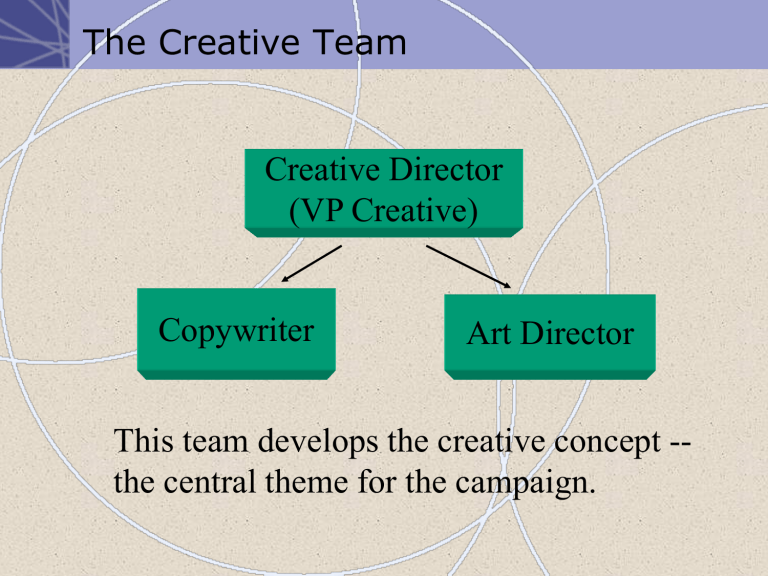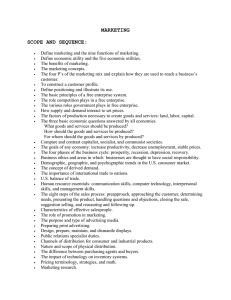The Creative Team Creative Director (VP Creative) Copywriter

The Creative Team
Creative Director
(VP Creative)
Copywriter Art Director
This team develops the creative concept -the central theme for the campaign.
Positioning
Positioning
• “The art and science of fitting the product or service to one or more segments of the broad market in such a way as to set it meaningfully apart from competition.”
Market Position
• The reaction of the market to the firm’s marketing programs.
• The intended or unintended consumer beliefs of the organization’s efforts, not the current or past strategic plans of marketing managers.
Illustration of Market Positioning Strategy
Example: Canadian Airlines
Brand Position Illustration By Attributes
Brand Position Illustration By Benefits
Positioning by Price/Quality
© 2005 McGraw-Hill Ryerson Limited
Brand Positioning Strategy Decision Process
Assess Consumers’
Perceptions of Competitors
Determine Competitors’
Positions
Analyze the Consumers’
Preferences
Make the Brand Positioning
Strategy Decision
Monitor the Position
Implications
• Brand positioning strategy decision is an important requirement for:
– Setting the overall business strategy
– Content of the advertising message
– Creative strategy
– Tactics
Creative Challenge
• The job of the creative team is challenging:
– Every marketing situation is different, and each campaign or advertisement may require a different approach.
• There are guidelines for creating effective advertising, but there is no magic formula.
Getting Creative Input
Use the product to
Read anything related to the product or market!
Listen to what people are talking about!
Work in and learn about the client’s business
Ask everyone involved for information!
The Creative Process
Verification
A Sudden Inspiration or Intuitive
Revelation About a Potential Solution.
Studying the Idea, Evaluating It, and
Developing It for Practical Usefulness.
Copy Platform
6. Supporting Information and Requirements
Example
Volvo “Cross Country”
1. Key Benefit
• Goes off road
2. Support Claims
• Picture of it outside
© 2005 McGraw-Hill Ryerson Limited
© 2005 McGraw-Hill Ryerson Limited
Other examples
FOR THE FOLLOWING ADS:
1. What are the Key Benefits?
2. What are the Support Claims?
© 2005 McGraw-Hill Ryerson Limited
© 2005 McGraw-Hill Ryerson Limited
© 2005 McGraw-Hill Ryerson Limited
© 2005 McGraw-Hill Ryerson Limited
Evaluation Guidelines
• Is the ad consistent with the marketing objectives?
• Does the ad communicate what it’s supposed to?
• Does it communicate a clear, convincing message?
• Is it an appropriate style for the product?
• Does the execution overwhelm the message?
• Is it appropriate for the target audience?
• Is the advertisement truthful and tasteful?
© 2005 McGraw-Hill Ryerson Limited
© 2005 McGraw-Hill Ryerson Limited
© 2005 McGraw-Hill Ryerson Limited
© 2005 McGraw-Hill Ryerson Limited
© 2005 McGraw-Hill Ryerson Limited
© 2005 McGraw-Hill Ryerson Limited
Quote of the Day









